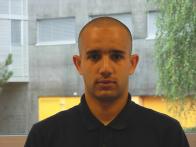Contact
Email : Rafik.Mebarki@irisa.fr
Address : IRISA / INRIA Rennes
Campus Universitaire de Beaulieu
35042 Rennes cedex - France
Tel : +33 2 99 84 25 45
Fax : +33 2 99 84 22 52
Assistant : +33 2 99 84 22 52
(Céline Ammoniaux)

Rafik Mebarki was born in Algeria in April 1983. He graduated with the Engineer degree in automatic control from the National Polytechnic School of Algiers of Algeria in 2005. He received the M.S. degree in Automatic Systems from the Paul Sabatier University of Toulouse, France, in June 2006. He performed his Ph.D. work at IRISA, INRIA Rennes, from October 2006 to mid-December 2009. He was that time working with Alexandre Krupa and François Chaumette, in the Lagadic Team.
His research work includes visual servoing and robotics, especially visual servoing from 2D ultrasound images for medical robotics. It concerns the development of a new visual servoing method to guide a 2D ultrasound probe, held by a medical robot, using the 2D images it provides.
R. Mebarki & al. developed a new visual servoing based on 2D ultrasound image moments and results have been obtained. The method uses combinations of image moments as input to the visual servoing scheme.
A manner a 2D ultrasound probe interacts with its environment differs totally from an optical system. Indeed, a 2D Ultrasound probe provides a cross-section image of the observed object. In other words, such a sensor provides full information only in its observation plane but none outside of it. In contrary, an optical system, like a camera for instance, provides a projection of the 3D world to a 2D image and, consequently, the existing visual servoing methods, most of them devoted for such a system, can not be used in the case of 2D ultrasound. Thus, new techniques have to be developed. R. Mebarki & al. developed a new visual servoing that automatically guide a 2D ultrasound probe from the images its provides. Opting for image moments seems a judicious direction. Indeed, Image moments are intuitive with geometrical interpretation, where their low order are directly related to the area and the gravity center of the observed section in the image. They have been widely used in pattern recognition. Moreover, these features do not necessitate a matching of the points in the image but only a global segmentation of the section in the image. They are also robust to perturbations, which is of great interest in ultrasound images, that are inherently very noisy.
This video (4.9 MB mpeg-4 file) shows the first result they obtained during an ex-vivo experiment. A medical robot arm actuates a 2D ultrasound probe interacting with a motionless rabbit heart immersed in a watter-filled tank. That soft tissue object is fitted with an ellipsoid whose 3D parameters are assumed coarsely known.
|
| The videos video1, video2, and video3 show experiments of tracking two soft tissue objects. The latter are inside an ultrasound phantom, which is manually moved. The 2D ultrasound probe is actuated by a 6 DOFs robot arm, which had been newly acquired. The robotic task consists in stabilizing the robotized probe with respect to the two targets (i.e., the ultrasound phantom). It is achieved thanks to the visual servoing method developed an presented in Mebarki et al. 2010 TRO journal paper. The method consists in a model-free visual servoing approach. It does not require any prior knowledge of the shape of the objects, their 3-D parameters, nor their 3-D location. Only the acquired (observed) image, along with the robot odometry, is used to compute the control commands to the robot. |
Complete list (with postscript or pdf files if available)
|
| Lagadic
| Map
| Team
| Publications
| Demonstrations
|
Irisa - Inria - Copyright 2009 © Lagadic Project |